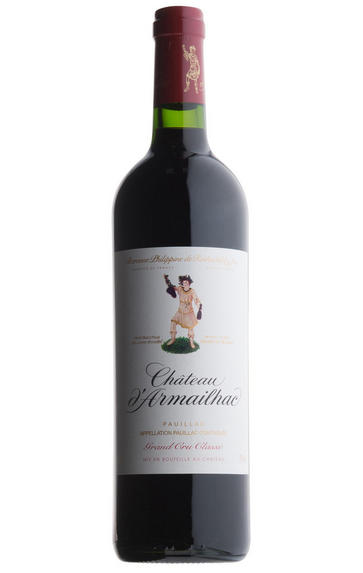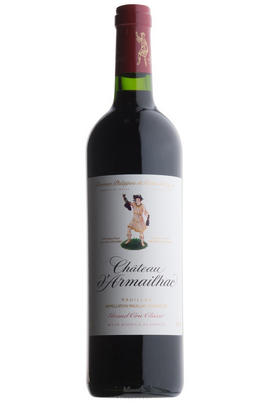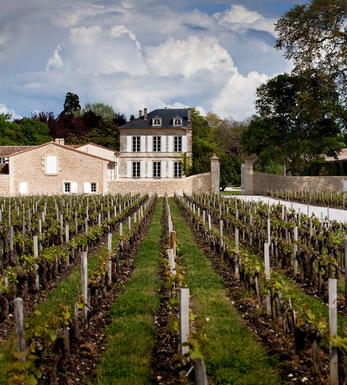
2021 Château d'Armailhac, Pauillac, Bordeaux

Critics reviews
The 2021 d'Armailhac, aged in 50% new oak, is the first vintage to be vinified in the new winery, which was completed a month before the harvest. It has quite a strict bouquet, tight and focused, with broody dark berry fruit, pencil box and tar, quite classic in style. The palate is harmonious and smooth with fine tannins, just the right amount of acidity and a sapid finish that lingers in the mouth. Residual graphite notes linger after the wine has exited. Very fine.
Neal Martin, vinous.com, (May 2022)
Lisa Perrotti-Brown MW , The Wine Independent (May 2022)
First year with the new cellar at Armailhac, and a new technical director, as Lucie Lauilhé has replaced Jean-Paul Paultert, with Paultert retiring after 29 years in the post (Lauilhé was only present for harvest and blending, 2022 will be her first full year). There are big plans for this property, but in 2021 it is playing things a little safe, with juicy balance, delicate tannins, plenty of grip and precision to the raspberry and blackberry fruits, but a little soft on the finish. There is due to be a 2nd wine in the future, which will help with concentration, but the signature of 2021 is evident here. A little more Cabernet Franc, after poor fruit set with the Melrot. 3.73ph. 50% new oak, 60IPT. Tasted twice.
Drink 2026 - 2038
Jane Anson, janeanson.com (May 2022)
Reminiscent of a modern-day version of this estate's delicious 1999, the 2021 d'Armailhac is a terrific wine bursting with aromas of wild berries, cherries, exotic spices and rose petals. Medium to full-bodied, supple and seamless, it's fleshy and enveloping, with melting tannins and an ample core of sweet, succulent fruit. This is a pleasure-bent wine that will offer a broad drinking window.
William Kelley, Wine Advocate (Apr 2022)
Fragrant nose with brambly fruit and floral notes. Fresh, fruity and sapid on the palate with grainy tannin in behind. Lacks intensity but zest and energy to compensate. More for the medium than long term
James Lawther, jancisrobinson.com (May 2022)
About this WINE

Château d'Armailhac
Classified as a Fifth Growth in 1855, Château d’Armailhac came under the ownership of the Baron Philippe de Rothschild family in 1933. Today Baroness Philippine’s children, Camille and Philippe Sereys de Rothschild and Julien de Beaumarchais de Rothschild continue the family’s quest for excellence and innovation in the vineyard and winery.
The 76-hectare estate is managed alongside stablemates Château Mouton Rothschild and Château Clerc Milon; expertise is shared across the properties.
The south-facing vineyard is located in the northern part of Pauillac, adjacent to Château Mouton Rothschild, and is made up of deep, gravelly soil favoured by Cabernet Sauvignon. It’s no surprise, then, that this grape dominates the planting with the rest given over to Merlot (35%), Cabernet Franc (8%) and Petit Verdot (2%). The Cabernet Franc vines, which have an average age of 60 years, derived from ancestral massal selection, make up a relatively high proportion of the blend and are a hallmark of the wine. Harvesting is done by hand, and the grapes are sorted and destemmed.

Pauillac
Pauillac is the aristocrat of the Médoc boasting boasting 75 percent of the region’s First Growths and with Grand Cru Classés representing 84 percent of Pauillac's production.
For a small town, surrounded by so many familiar and regal names, Pauillac imparts a slightly seedy impression. There are no grand hotels or restaurants – with the honourable exception of the establishments owned by Jean-Michel Cazes – rather a small port and yacht harbour, and a dominant petrochemical plant.
Yet outside the town, , there is arguably the greatest concentration of fabulous vineyards throughout all Bordeaux, including three of the five First Growths. Bordering St Estèphe to the north and St Julien to the south, Pauillac has fine, deep gravel soils with important iron and marl deposits, and a subtle, softly-rolling landscape, cut by a series of small streams running into the Gironde. The vineyards are located on two gravel-rich plateaux, one to the northwest of the town of Pauillac and the other to the south, with the vines reaching a greater depth than anywhere else in the Médoc.
Pauillac's first growths each have their own unique characteristics; Lafite Rothschild, tucked in the northern part of Pauillac on the St Estèphe border, produces Pauillac's most aromatically complex and subtly-flavoured wine. Mouton Rothschild's vineyards lie on a well-drained gravel ridge and - with its high percentage of Cabernet Sauvignon - can produce (in its best years) Pauillac's most decadently rich, fleshy and exotic wine.
Latour, arguably Bordeaux's most consistent First Growth, is located in southern Pauillac next to St Julien. Its soil is gravel-rich with superb drainage, and Latour's vines penetrate as far as five metres into the soil. It produces perhaps the most long-lived wines of the Médoc.
Recommended Châteaux
Ch. Lafite-Rothschild, Ch. Latour, Ch. Mouton-Rothschild, Ch. Pichon-Longueville Baron, Ch. Pichon Longueville Comtesse de Lalande, Ch. Lynch-Bages, Ch. Grand-Puy-Lacoste, Ch, Pontet-Canet, Les Forts de Latour, Ch. Haut-Batailley, Ch. Batailley, Ch. Haut-Bages Libéral.

Cabernet Sauvignon Blend
Cabernet Sauvignon lends itself particularly well in blends with Merlot. This is actually the archetypal Bordeaux blend, though in different proportions in the sub-regions and sometimes topped up with Cabernet Franc, Malbec, and Petit Verdot.
In the Médoc and Graves the percentage of Cabernet Sauvignon in the blend can range from 95% (Mouton-Rothschild) to as low as 40%. It is particularly suited to the dry, warm, free- draining, gravel-rich soils and is responsible for the redolent cassis characteristics as well as the depth of colour, tannic structure and pronounced acidity of Médoc wines. However 100% Cabernet Sauvignon wines can be slightly hollow-tasting in the middle palate and Merlot with its generous, fleshy fruit flavours acts as a perfect foil by filling in this cavity.
In St-Emilion and Pomerol, the blends are Merlot dominated as Cabernet Sauvignon can struggle to ripen there - when it is included, it adds structure and body to the wine. Sassicaia is the most famous Bordeaux blend in Italy and has spawned many imitations, whereby the blend is now firmly established in the New World and particularly in California and Australia.


Buying options
Add to wishlist
Description
Cabernet Sauvignon 63%, Merlot 22%, Cabernet Franc 13%, Petit Verdot 2%
New director Lucie Lauilhé worked this vintage with the retiring Jean-Paul Polaert. There is an unusually high proportion of very old Cabernet Franc vines here, which have become very well adapted to the property’s sandier soils. Although the estate adjoins, and is under the same ownership as, Château Mouton Rothschild, these elements give the wine a distinct style. The 2021 is particularly aromatic, with floral notes of lilac and rose. The palate is graceful and svelte, even understated. There’s a sense of delicacy and appealing airiness; the finish will blossom after more time in barrel. Drink 2026-2038.
Our score: 17/20
Berry Bros. & Rudd, April 2022
wine at a glance
Delivery and quality guarantee